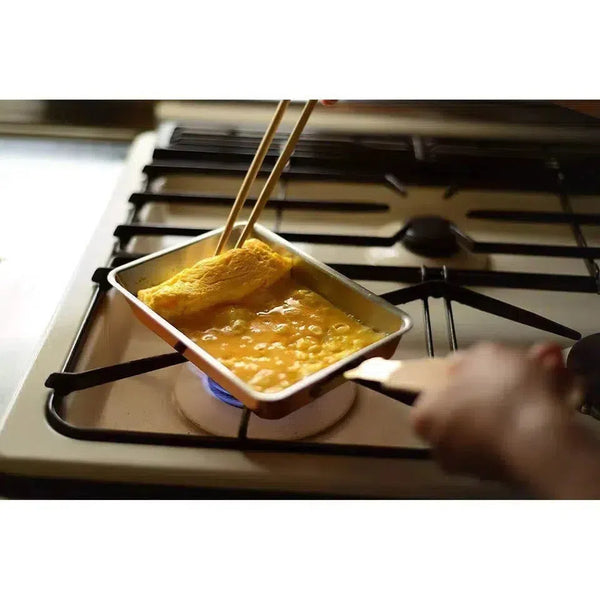
Jump to:
Tamagoyaki Pan Overview
Are you familiar with the Japanese tamagoyaki pan? It’s a common, square or rectangular-shaped pan that exists in just about every Japanese household. It’s used for making the famous Japanese layered omelet tamagoyaki. Tamagoyaki is a common breakfast, snack, and even lunch box item in Japan, and it has picked up quite a bit of popularity in recent years overseas, too. These days, western manufacturers are also coming out with their own versions of these small pans.
Maybe the thought of purchasing a pan intended for making tamagoyaki sounds like a waste of money, but that sentiment is far from the truth. In fact, tamagoyaki pans can be used in many more ways than just making rolled omelets.You can make toasted sandwiches, french toast, sear proteins, deep fry foods in small batches, there are even oven safe versions of tamagoyaki pans that can act as baking vessels for cakes or brownies!
Now that you know how tamagoyaki pans are versatile, maybe you’re thinking about purchasing one. But wait, there’s so many options. Which one should you go with? What about purchasing one made from a foreign company versus a Japanese one? Are the Japanese options really worth their craftsmanship and authenticity? What about the material of the pan? And the list goes on, and on…and on.
Don’t worry though, we’ve got you covered. In this article we will answer all of those questions and more.
We’ll go over:
- The shapes of Tamagoyaki Pans
- What materials are commonly used
- Our 5 recommended Tamagoyaki Pans that can be purchased on Japanese Taste
Tamagoyaki Pan Shape

First, let’s talk about the shape of the tamagoyaki pan. The square shape might be the more widely recognized shape, but there are also rectangular versions of this pan available. In fact, it can be said that the square shape is commonly used in the Kanto, or Tokyo region, while the rectangle shape is commonly used in the Kansai, or Osaka region. The square shape will lead to a wider tamagoyaki, while the rectangular shape will lead to a thicker tamagoyaki with more layers. It should also be noted that cooking tamagoyaki in a rectangular pan is easier for beginners.
Maybe you’re also wondering, can’t I just make tamagoyaki in a small round frying pan? While yes, you certainly can, it is much harder to get the shape right. Shaping the tamagoyaki in a round pan also takes more time, which will result in the egg becoming overcooked and maybe even turning too brown. It’s also fun cooking tamagoyaki in a square pan! Creating a tamagoyaki with fluffy, beautiful layers and a vibrant yellow color is such a satisfying feeling.
Lastly, the shape is related to the size of the pan. Square pans have a capacity to fit more eggs, while rectangular pans are narrow, and may only be able to fit a few eggs. Whether you live alone or have a large family, the size of the pan you purchase may be another factor that you want to consider.
Tamagoyaki Pan Material

The material of the pan is another worthy point of interest. Authentic tamagoyaki pans are usually made out of cast iron or copper. There are non-stick options available, and while they may be cheaper, we would not recommend them. For one, non-stick pans are usually coated with polytetrafluoroethylene, what is commonly known as Teflon. We won’t go into much detail about Teflon, but there are many people who feel that using teflon-coated cookware is unsafe for their health. Not to mention that the non-stick coating on these pans does not last forever. Therefore, despite the cheaper price tag on non-stick tamagoyaki pans, you may not be able to get as much use out of them.
Cast iron and copper are favorable materials for crafting authentic tamagoyaki pans because they are great conductors of heat. They allow heat to spread evenly on their surfaces, resulting in an evenly cooked end-product. Not to mention, they are also high quality materials that will last for a long time, if taken care of properly. While the cost of purchasing a cast iron or copper pan is higher than non-stick, you may be able to keep these pans for generations!
Now without further ado, let's look at the 5 recommended tamagoyaki pans that you can purchase on Japanese Taste.
Best Cast Iron Tamagoyaki Pan
Summit Square Cast Iron Tamagoyaki Pan (Japanese Omelette Pan)
Summit’s Square Tamagoyaki pan is a cast iron pan with a wooden handle, featuring a square shape. The square shaped tamagoyaki pan is popular in the Kanto, or Eastern region of Japan. (Think, Tokyo).
Cast Iron requires a bit more love and attention than non-stick pans, but once you get the hang of caring for them, they will last for years. They are also relatively inexpensive compared to copper and stainless steel pans.
Another great point about this tamagoyaki pan is that it is thick, allowing the evenness of heat conduction. Heat conduction is one of the most important things to consider when making tamagoyaki, because even heat conduction allows you to end up with a vibrantly yellow, and evenly cooked tamagoyaki.
The wooden handle on this pan also allows you to cook safely without the risk of burning yourself. It is convenient for both cooking and serving whatever you are making with this pan.
This cast iron pan is compatible with various heat sources including both gas and IH induction. It is a pan that can be welcomed into anyone’s kitchen!

[callout-1]
Best Tamagoyaki Pan For Beginners
Summit Rectangular Cast Iron Tamagoyaki Pan (Japanese Omelette Pan)
This is the rectangular version of Summit’s Cast Iron Tamagoyaki Pan. As previously mentioned, rectangular-shaped pans are much more common in the Kansai, or Western region of Japan. (Think, around Osaka and Kyoto).
A reason to consider purchasing a rectangular shaped pan over a square shaped pan is if you are new to making tamagoyaki. Making a fluffy and delicious tamagoyaki takes some practice and time. Knowing when the tamagoyaki layers are ready to flip, and shaping the omelet correctly comes with skill. It is much easier to create perfectly shaped layers in a rectangular pan than a square pan given the dimensions.
A rectangular pan may also be ideal for cooking for smaller amounts of people. This pan only has the capacity to hold two or three eggs, so it may not be the most convenient pan for those with larger families, (unless you don’t mind making many batches of tamagoyaki.) However, if you live alone or are cooking for yourself and one other person, then this rectangular pan will be the perfect size.

[callout-2]
Best Tamagoyaki Pan For Gas Stoves
Nakamura Copper Tamagoyaki Pan Japanese Omelette Handmade Pan
This is the most expensive option on the list, but if you love tamagoyaki and plan on making it frequently, then this is the perfect tamagoyaki pan for you. This is a square shaped copper pan designed to make flawless tamagoyaki every. single. time. Copper pans are phenomenal for cooking because they can retain and spread heat evenly across the surface of the pan. They are durable, are not prone to high heat damage, and will last a lifetime. They are also commonly used in Japanese restaurant kitchens as well.
The reason why this pan is so pricey is not only because it is made out of copper, but also because each pan is handmade by the family-owned Nakamura business in Tokyo. Each pan is held to a standard of extreme quality and care, as well as uniqueness. No two pans will come out looking exactly the same, so each pan has its own individual charm. There is a sense of genuineness with each pan, and it is rare to find tamagoyaki pans from other makers that share this quality.
While this pan was intentionally created for making tamagoyaki, you can also make many other things with it. In fact, you can deep fry small things such as donut holes or even bake brownies with it! (Yes! This pan is oven safe by the way.)
A few notes about this pan is that it is not compatible with IH conduction stoves. In order to use this tamagoyaki pan, you must use a gas stove. It is also not dishwasher safe. Please be sure to wash this pan by hand.

Most Versatile Tamagoyaki Pan
Takumi Japan Iron Tamagoyaki Pan (Japanese Omelette Pan)
This is another great cast iron tamagoyaki pan option! The Takumi Japan line is a flagship brand under ‘Nihon Yoshikki’ - a highly reputable Japanese kitchenware maker.
The key feature of this tamagoyaki pan is its magma plate. The magma plate is a specialty iron with a concave-convex surface. This kind of surface results in more efficient oil distribution and less food sticking or burning even when used at high heat. Heat is quick and even in conductivity, which locks in the flavor of whatever you are making. In other words, you can make some really delicious tamagoyaki with this pan!
The magma plate feature is also an excellent option for grilling meats. You can grill chicken, steak, fish, or your desired meat of choice beautifully in this tamagoyaki pan.
This pan also has a wooden handle, making it easy to cook with and safe to hold, because the handle does not become hot when the pan is heated.

[callout-3]
Best Tamagoyaki Pan For Making All Egg Dishes
Iwachu Nambu Japanese Cast Iron Tamagoyaki Pan 24017
This Iwachu Nambu Japanese Cast Iron Tamagoyaki Pan is another excellent cast iron tamagoyaki pan. It has the same heat retention properties as the other cast iron pans, and will last a very long time if properly cared for. Since it is cast iron, it is also compatible with both gas and IH conduction.
What sets this tamagoyaki pan apart from the other cast iron options listed in this article are the versatility of dishes that this pan was implied for. Yes, it has a square shape and will make scrumptious tamagoyaki. However, this pan is also a phenomenal choice for making other egg dishes. This pan’s square shape makes it ideal for making scrambled eggs, skillet quiche, frittata, and more.
Similarly to the other cast iron pans, this pan also has a wooden handle, making it extremely easy and safe for handling. Another key difference with this Iwachu cast iron tamagoyaki pan is that it already comes pre-seasoned. This means that the foods that you are cooking will not stick to the surface of the pan, even when you start using it. You don’t even need to add additional oil to the pan! It will require additional and proper cast iron seasoning maintenance, though.

[callout-4]
The Choice is Yours
No matter which pan you choose from this list, you are bound to end up with a high quality tamagoyaki pan. It just comes down to asking yourself what you want:
- Do you prefer a metal or copper pan?
- Do you prefer a square or rectangular-shaped pan?
- Do you plan on using this pan for other uses besides making tamagoyaki?
- Are you going to be making tamagoyaki for yourself? Or are you going to be making and using this pan to feed more than one person?
- What is your budget?
Once you think about what is important to you, then go ahead and give any one of these recommended tamagoyaki pans a go!


0 comments